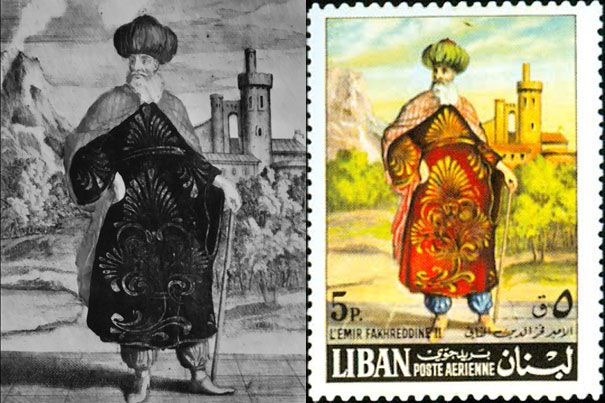
Vengeance
Fakhreddine could not take the humiliation of the previous battle and was still decided to take his vengeance and kept planning for it secretly. When the time came, he united his troops and those regrouped by Abou-Nader in Nahr Ibrahim and stormed the Ottoman Saifa stronghold, demolishing his castle and inflicting on him a humiliating defeat. Added to that, he ordered his troops to carry the stones from the castle all the way up to Deir el Kamar for him to rebuild his demolished castle with them. Fakhreddine thanked the Khazens for their help and rewarded them by appointing Abou Nader as the right hand to the governor of Keserwan, Jbeil and Batroun. Msayleh was built at the time for surveillance purposes.
Having finally claimed his vengeance, Fakhreddine made use of his stay in Tuscany and took several measures to improve the country, enhance the economy and build a 45,000 Sokman-strong army. He also forced the farmers to enroll in the army and report to duty once per week. This helped him maintain 15,000 trained men from different confessions and social classes ready to confront any attack. Damascus’ Pacha wasn’t very happy about Fakhreddine’s dominance and he attempted in 1623 to attack him in Anjar but Fakhreddine inflicted yet another humiliating defeat to the Ottomans. As a result, he was named “Sultan of the Continent” and became the most powerful prince of that era with an empire extending from Antioch in the North to Palmyre in the East and Safad in Galileo in the South.
Aleppo was also part of Fakhreddine’s empire and he was more and more relying on the help of Abou-Nader who used to carry the prince’s orders all the way from Beyrouth to Akkar passing by Nahr Ibrahim. He even got to Aleppo where he ordered the construction of two citadels, one on the left of CHamamiss’s citadel and another in Antioch. He also built a citadel in Kab-Elias and ordered to have another in Msayleh in Batroun. More importantly, he ordered to restore the Baalbeck ruins. All these construction works caused the death of Abou-Nader’s first son Nawfal (a name he gave to another son afterwards) after an earth quake led Smar’s citadel to crumble.
Peak and Decline
The Fakhreddine era was the golden age for Lebanon and the Lebanese from all religions. Everyone was living in prosperity and able to feed their families. However everything good ends at some point and Fakhreddine made one fatal mistake that cost me his whole empire. He decided in 1630 to take out one of the many privileges the Ottoman Empire, one related to the ongoing trade with Tuscany and the credential letters for the arriving boats. This privilege was exclusive to Sultan Mourad IV who had just won a major victory against Iran’s Shah. As a result, he ordered Damascus’ Kutchuk Pacha to dismiss the Prince and attack him by land while the Ottoman fleet surrounds Fakhreddine by sea. Fakhreddine saw his son Ali, his brother Younes and the elite of his army fall in battle and had to surrender. He was taken with his family to Constantinople where Mourad IV condemned him and his 3 brothers, Mansour, Haidar and Boulouk to death in 1635.
As for Abou-Nader and his uncle Abou-Safi, Emir Ali Alameddine helped them regain Keserwan but Emir Hassan and his moudabber Abou-Nawfal weren’t that lucky and were made prisoners by Khalil Pacha in Aleppo. However, Abou Nawfal was able to run away and regain Keserwan, only to find out his properties and those of the Hobeich family were confiscated by Emir Ali Alameddine. Abou-Nader, his son Abou Nawfal and his brother Abou-Khattar fled to Tuscany where they were taken in and treated as noble by the Grand Duc of Florence.
Kayssites vs. Yemenites
The end of the Fakhreddine rule plunged Lebanon into a turbulent chapter where Emirs and Cheikhs were fighting violently over Fakhreddine’s heritage and trying to gain some of his power and lands. In fact and in 1636, Kutchuck Pacha decided to get rid of the Maans and took out Emir Melhem, son of Younes and the legitimate heir of the Fakhreddine. He placed instead as chief of the Chouf area the prince Ali Alameddine, who was a member of the adverse Yemenites clan. In fact, Kayssites and Yemenites, two tribes that originated from Arabia and Yemen, were always fighting over Lebanon, with the Kayssites being always led by a Maan and having a dominance in the Khazen’s Keserwan. Having said that, an understanding was reached between the Aga of Damascus Ahmad Chamli and Emir Assad Sa’I’fa to get rid of Alameddine under the pretext that he wasn’t paying their share of the taxes collected. As a result, they sent an army of 7000 men that invaded Keserwan killed Alameddine, his family and a large number of partisans. Kayssites saw in this event a victory and all reunited around Emir Melhem, Fakhreddine the Great’s grandson, who took back the reign of the Chouf and Keserwan.
After learning the news, Cheikh Abou-Nader, his son Melhem and his brother Abou-Khattar came back from exil and as soon as they got to Lebanon, Emir Melhem gave them back their lands and Keserwan’s governorate which extended from Jebbet-Becharre to the borders of Beirut. Abou-Nader was placed back as Moudabber as well.



